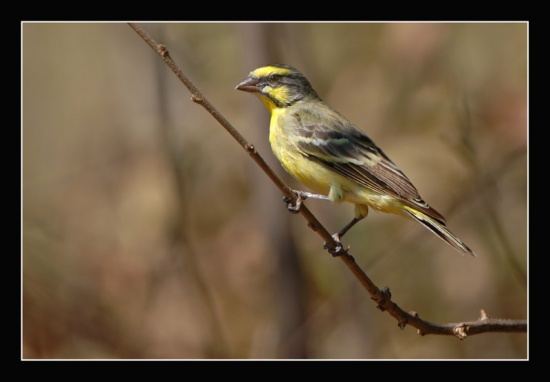- Crithagra mozambica
Serinus mozambicus
Identification
11–13 cm (4¼-5 in)
- Green back
- Broad supercilium
- Yellow head, underparts and rump
- Grey crown and nape
- Black malar stripe
- Brown wings and short tail
Female: similar, though has duller underparts and less marked head pattern
Juveniles: greyer than the female, especially on the head.
Distribution
Sub-Saharan Africa:
Western Africa: Mauritania, Senegal, The Gambia, Guinea-Bissau, Mali, Sierra Leone, Liberia, Ivory Coast, Burkina Faso, Ghana, Togo, Benin, Nigeria, Niger, Chad, Cameroon, Central African Republic, Equatorial Guinea, Gabon, Democratic Republic of Congo, Angola
Eastern Africa: Sudan, South Sudan, Eritrea, Ethiopia, Kenya, Uganda, Rwanda, Burundi, Tanzania, Zambia, Mozambique, Malawi
Southern Africa: Namibia, Botswana, Zimbabwe, South Africa, KwaZulu-Natal, eSwatini.
Introduced to many countries including the Hawaiian Islands, where it is common and widespread.
Taxonomy
Formerly placed in genus Serinus.
Subspecies
Clements recognises the following subspecies [1]:
- C. m. caniceps: Senegal to Cameroon (south to Benue plain)
- C. m. punctigula: Cameroon (north to Toukte, Grand Capitaine and Koum)
- C. m. tando: Gabon to northern Angola and south-western Democratic Republic of the Congo; introduced São Tomé
- C. m. vansoni: Extreme south-eastern Angola and adjacent Namibia to northern Botswana, south-western Zambia
- C. m. barbata: Southern Chad, Central African Republic, western Sudan, western and southern South Sudan, eastern Democratic Republic of the Congo, Uganda, southwestern Kenya, and central Tanzania
- C. m. samaliyae: South-eastern Democratic Republic of the Congo to south-western Tanzania and adjacent Zambia
- C. m. grotei: Southeastern Sudan (east of the Nile), eastern South Sudan, and western and southwestern Ethiopia
- C. m. gommaensis: Eritrea and northwestern and central Ethiopia
- C. m. mozambica: coastal Kenya and Mafia Island (Tanzania) south to Zimbabwe, Mozambique, eastern and south-eastern Botswana, and north-eastern South Africa (North West and Limpopo to Free State)
- C. m. granti: eastern South Africa (Mpumalanga and KwaZulu-Natal south to Eastern Cape), eastern eSwatini, and southern Mozambique
Habitat
Lowland open woodland, bush, scrub, savanna, agricultural land, gardens.
Behaviour
Breeding
They build a compact nest in trees; the clutch consists of 3–4 eggs.
Diet
Their diet consists mostly of grass and weed seeds; other plant material such as buds, flowers and leaves. They also eat insects.
Vocalisation
Song, often given in short bursts, is a lively series of sweet, musical phrases similar to Common Canary but weaker and with a more ringing quality. Call is a low double note.
Movements
Resident and partially nomadic. In non-breeding season large flocks wander in search of food.
References
- Clements, J. F., T. S. Schulenberg, M. J. Iliff, S. M. Billerman, T. A. Fredericks, B. L. Sullivan, and C. L. Wood. 2019. The eBird/Clements Checklist of Birds of the World: v2019. Downloaded from http://www.birds.cornell.edu/clementschecklist/download/
- Avibase
- Clement, P. (2020). Yellow-fronted Canary (Crithagra mozambica). In: del Hoyo, J., Elliott, A., Sargatal, J., Christie, D.A. & de Juana, E. (eds.). Handbook of the Birds of the World Alive. Lynx Edicions, Barcelona. (retrieved from https://www.hbw.com/node/61308 on 8 February 2020).
- Clement, P., A. Harris, and J. Davis. (1993). Finches and Sparrows: An Identification Guide. Princeton Univ. Press, Princeton, N. J.
- Pratt, H.D., Bruner, P., and Berrett, D.G. (1987) A Field Guide to the Birds of Hawaii and the Tropical Pacific. Princeton University Press.
- Pyle, R.L., and P. Pyle. 2017. The Birds of the Hawaiian Islands: Occurrence, History, Distribution, and Status. B.P. Bishop Museum, Honolulu, HI, U.S.A. Version 2 (1 January 2017) http://hbs.bishopmuseum.org/birds/rlp-monograph/
- Zuccon, D., Prys-Jones, R., Rasmussen, P., Ericson, P.G.P. (2012). The phylogenetic relationships and generic limits of finches (Fringillidae). Molecular Phylogenetics and Evolution. 62 (2): 581-596.
- Wikipedia contributors. (2019, December 28). Yellow-fronted canary. In Wikipedia, The Free Encyclopedia. Retrieved 09:16, February 10, 2020, from https://en.wikipedia.org/w/index.php?title=Yellow-fronted_canary&oldid=932753850
- BirdForum Member observations
Recommended Citation
- BirdForum Opus contributors. (2024) Yellow-fronted Canary. In: BirdForum, the forum for wild birds and birding. Retrieved 25 April 2024 from https://www.birdforum.net/opus/Yellow-fronted_Canary
External Links
GSearch checked for 2020 platform.1





